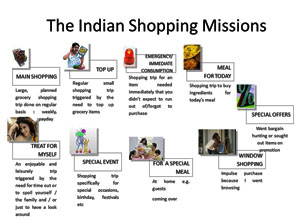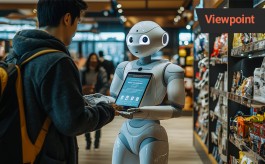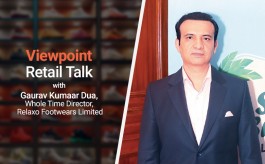Home » Viewpoints » 'Shopper marketing initiatives should be aligned with sensitivity of consumers'
'Shopper marketing initiatives should be aligned with sensitivity of consumers'
By Nabamita Chatterjee | May 30, 2014
Consumer empowerment is the next buzzword, says Ramendra Singh, Assistant Professor & Group Coordinator (Marketing) of Indian Institute of Management, Calcutta. Point-of-Purchase chats up with him to know more about the shopper marketing scenario of the country. Read on:
 What steps do you advocate to gain robust insights on shopper behaviour in India?
What steps do you advocate to gain robust insights on shopper behaviour in India?While shopper marketing is a recent approach from marketers in India, it has a lot of potential to tap into the latent desires of the unassuming and silent Indian consumers. In my belief, consumer is one who can be sold what s/he wants, the right product, at the right time, at the right place, and at the right value. All this becomes more do-able using techniques and concepts of shopper marketing. In the world of shopper marketing, desire or want is, among other things, a function of place and time. For example, in a famous experiment done in the US, chilled beer on the beach (where tourists are resting and having sunbath) is usually likely to be sold at a higher price than at a place 100 meters away from the beach. Shopper marketing therefore has to capture value not only at every location where shopper travels, but also develop deeper insights into her mind to capture value as a function of time. For example, Coke few decades back decided to price their drink based on ambient weather conditions. They decided to increase prices on a hot day, and drop prices on a chilly day…however, consumers hated this news when it came out, and stock prices as well as top management had to take a hit. So, one has to also be careful when dealing with sensitivity of consumers.
One also must be wary of the fashionable terms and jargons that keep mushrooming all the time. To gain robust insights on shopper behaviour, while big data and other analytics may be used, there is no substitute for plain simple common-sensical understanding of the Indian female and male consumer. Marketers must not forget that consumption happens in the context of lifestyles of consumers, and products, and services being bought and consumed at any retail store at any given time reflects this consumer lifestyle and aspirations.
Understanding the consumer mind today needs more common sense than use of super- sophisticated techniques such as big data analytics or neuro-marketing. Tools and techniques are always useful, but they cannot be a substitute for consumer insights, and shopper marketing is all about generating consumer insights and leveraging them to sell successful products by delivery of high value to consumers at the right time, and every time.
At the very basic level, marketers need to go back to basics and see how and when does a consumer buy, when does she shop, why, and where. The concept of market segmentation is also obsolete, although useful. One-to-one marketing is what today consumer wants, and the mobile-based social media is a very useful media to use for shopper marketing. The concept of planned and unplanned purchases, the concept of impulse purchases, the concept of shopper basket, and similar such concepts need to be re-looked critically in the light of substitute products and services available at the tap of a touch-screen on the smart phone.
Every product is becoming secondary and the experience surrounding its consumption and purchase is becoming primary to consumers. It is not so much about what to buy, but also about where to buy and how to buy. It is not so much about whether to buy…but about when to buy. Self is the new key word in shopper marketing, and even within a single consumer, there are many selves. Therefore, identifying and pampering all the selves in the same individual consumer is the next challenge for the marketers.
I also resist the concept of DNA of a consumer. To me, consumption is a function of desire and not needs, and so predicting the DNA of consumers to predict consumption is erroneous. The challenge is to market the best product to every potential consumer, rather than identifying who my consumer is. To me, everyone is a consumer all the time. Therefore, companies are needlessly drawing boundaries on their markets, and segments. If they can provide the space and resources to everyone to create value for themselves, then they are creating eco-systems where everyone is a consumer at some point of time. What part of that eco-system an organisation wants to occupy and where does it partner with other organisations in the eco-system is for them to decide. The emphasis must shift from products to consumers and from price to value. Consumer empowerment is the next buzzword.
 Are brands and retail outlets fully leveraging the data and insights available on shopper preferences and behaviour?
Are brands and retail outlets fully leveraging the data and insights available on shopper preferences and behaviour?I doubt if organisations such as producers or retail stores are fully leveraging the data and insights on shopper preferences and behaviours. One reason for that is very often we assume data to be insight. Insight is insight, data is data, and information is information. One cannot substitute one for the other. For example, big data predictive modeling promises to be able to predict the next purchase and point of purchase for consumers based on the history of all the purchases and other activities of the past. I find it difficult to understand how that can be. Without understanding the mind of the consumer, if we start trusting the data, that would be erroneous. We must trust our insights, and find evidence in data and not the other way.
Too much reliance on big data will not be give us insight about individual consumers. In the same way, how social media is used by consumers can generate insights which can be useful, but using that to predict the next purchase or behaviour or attitude is like trying to find a needle in a haystack. We should not waste too much time on predictive analytics. Insights come when you do FGDs, and in-depth interviews at the POP, or points of consumption (inside the consumers' homes). Ask them to brainstorm in your corporate offices (this may sound ridiculous to most organisations).
I remember reading a research article on the Harley Davidson brand community wherein one of the authors (who was also on the Harley board) discusses about how the brand team spends time with the communities, traveling with them, living with them for days to get insights about how the brand is doing, where next to take the brand, and so on. Brands have huge power, and marketers must not play with it casually. They can leverage it in many powerful ways. For example, big investors are now betting high on Big Bazaar's next expansion plans. Big Bazaar has huge equity in the market, which remains fully leveraged. In the same way, many retail brands, as well as product/service brands can leverage their brand equity by leveraging deeper consumer insights.
In this context, let me also highlight the failed brand extension of "New Coke" despite spending so much money on market research by the company. The consumers simply wanted their old Coke back. While on the other hand, successful brands such as Dettol have leveraged their brand equity so successfully in the market.
All-in-all driving consumption is the challenge that marketers must raise up to, rather than driving sales, which they are so much focused on right now. I think in many sectors, such as FMCG, auto and others, it is the sales departments that are doing their job (driving sales numbers) more than the marketing departments doing theirs (increasing consumer insights and driving successful innovation).
Marketers must also understand that consumers not only want products that meet their desires, but also want a say in its design and production of value from the product. Therefore, customisation of value is very important for them. For example, Amazon.com has started anticipated delivery of products before the customer actually orders (based on previous purchase history of the consumer). But why the consumer will like the products s/he actually bought in the past is more important than what s/he purchased last. Now, as a customer if I get the book delivered to me without ordering for it, would I be happy or annoyed? Wouldn't I like to order it myself when I want to…isn't ordering for the book also giving some satisfaction that is part of the value that I want from that product/service? Marketers must give consumers the freedom to decide what value they want and when and how…that is the key…so that is why I said consumer empowerment is the key to driving consumer value and that will come from getting consumer insights.
Today, customer loyalty programmes are in vogue to engage shoppers. Are we seeing more of the same across brands and outlets?
There is a bandwagon effect in having customer loyalty programmes. We also know that most of them are not very effective or too costly to be continued. At the end of the day, do customers really want to be rewarded for showing loyalty? Are we sure they want a reward over a long time, or every time? Is consumer really loyal? …and what is customer loyalty?
I think time has come to critically re-look the entire concept of customer loyalty. There is too much emphasis on customer loyalty programmes, rather than brand equity. That is where sales will usually win over marketing. Marketers want the easy and short path. Investing in customer loyalty programmes will drive revenues, but will it drive value? Recent research in marketing research shows that loyal customers are not most profitable to organisations. They are also not very good in bringing referral customers. If marketing has to win over sales, or at least play a more dominant role, then driving brand value through consumer insights would play a bigger role than rewarding customers for showing loyalty. If I am a customer with 10 loyalty programme cards, and I buy from all ten sellers, am I loyal to all…or to none? Therefore, this concept is flawed, and needs to be re-visited in today's context.
What are your impressions on point-of-purchase innovations used in India?
Point of purchase innovations are very new in India and have a lot of potential to scale up. Innovation unfortunately is being copied or inspired from what has been tried and tested successfully. What is missing are the consumer insights being used for innovation. For example, how delighted are the same consumers whenever they visit the same retail store? What are the innovations done in store displays, and store-level promotions? What is the customisation available for customers in the store? How do marketers and retail stores collaborate for these innovations? These are some of the important questions that need to be tackled, in my opinion.
Do you see a greater use of digital technologies like large touch-screen display innovations and applications to engage shoppers in-store?
The digital technology has just started to be used in a big way in India now. Therefore, we will see more use of these technologies, more visual and sensory equipment, and other gadgets and equipment to engage and excite the customers in several ways. However, behind all this, there has to be an experience that is integral to the values that the brand stands for, and that is relevant for the customer. Most often companies would just put up digital technologies, and other displays or applications that do not end up appealing to the customers too much. As I mentioned earlier, customer engagement and empowerment is the mantra in shopper marketing.
Is e-commerce complementing brick & mortar retail, or is it a perceived threat to this business?
I think e-commerce is more complementary rather than a threat to brick and mortar. Therefore, we are seeing both channels from the same organisations, hence the hybrid channels. Research has shown that customers want to use multiple channels at different points of their buying/shopping behaviour. Therefore, while internet is an effective channel for information seeking, and price comparisons, showroom is good for demo, while large independent stores may be good for purchase. However, it is specific to product categories, and varies from one category to another. So books may be predominantly online since we have moved from printed books to e-books, so is the same with movies, and music.
For apparels, since there is so much price differential, customers have moved in large numbers to purchase online. However, if we can control the huge price differences across channels, consumers will always prefer multi-channel shopping experiences. This gets validated from the fact that even after decades of organised retail stores, the small mom-and-pop stores have not really suffered, but adjusted their merchandise mix to make up for the changed scenario, and they still thrive.
In the same way, many small stores in remote peri-urban areas are now getting direct supplies from company's distributors; Small stores are becoming retail outlets while large stores will also serve more of a warehouse function for these small stores. So hybrid model of retailing is what we should expect in the next 10-15 years or so, all focused on providing the right experience for the consumer.
Advertisement
Related Viewpoints
Advertisement









Comments